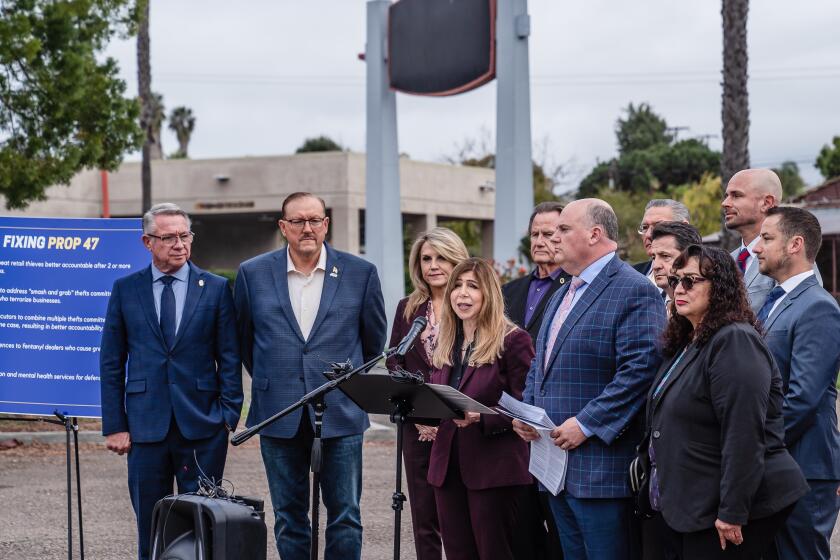Fires in North County closer to being out
View the Video Redeemer By The Sea
Cooler temperatures and higher humidity continued to help firefighters Sunday as they extended their hard-won upper hand against wildfires that destroyed homes and forced tens of thousands of people across the county to evacuate this past week.
A milestone was reached Sunday afternoon, when emergency officials lifted the last of the evacuation orders issued in recent days. In addition, school administrators announced that all of the campuses shuttered because of the blazes would resume classes today.
The overall battle isn’t over, but fire crews were closer to victory as once-raging blazes inched closer to full containment.
The Las Pulgas fire, which at 15,000 acres was the largest of a trio of blazes that have scorched parts of Camp Pendleton, was 75 percent contained as of Sunday night. The 1,500-acre San Mateo fire, also on Camp Pendleton, was 97 percent contained. And the Cocos fire, which burned more than 2,400 acres in and around San Marcos, was 87 percent contained.
Firefighters were able to focus their energy on dousing hot spots in fires mostly or fully under control, including: The Tomahawk fire, which started at the Fallbrook Naval Weapons Station and spread to Camp Pendleton; the Highway fire near Bonsall; the Bernardo fire, which affected areas southwest of Rancho Bernardo; and the Poinsettia fire in Carlsbad.
The most recent estimates show that more than 26,500 acres have been charred as of Sunday night. More than 55 properties were damaged or destroyed — including two apartment buildings in Carlsbad — and about $5.3 million have been spent to douse flames across the county.
A damage estimate for all burned properties was still being compiled, but property damage caused by the Poinsettia fire alone was estimated at $10 million to $15 million.
One fire-related death and at least three injuries have been reported.
View the photo gallery: Photos: A week of wildfires
As talk began shifting Sunday to recovery and rebuilding, many residents gathered in places of spirituality to reflect on the wildfires that had ravaged their communities.
Patches of badly burned ground were eerily close to one Carlsbad house of worship: Redeemer by the Sea Lutheran Church on Black Rail Road. The Poinsettia blaze came within a few feet of the grounds, and the church’s yard and trees looked extra green when compared with the blackened earth close by.
Pastor Augie Iadicicco stood at the pulpit Sunday morning. Behind him were photos he had taken the day the fire broke out. One showcased a group of teachers ushering small children from the church after its preschool and kindergarten were evacuated. Another showed a giant plume of smoke from flames that would soon encroach on the property.
And then a more personal photograph, one of Iadicicco’s family posing with a man he credited for saving their home.
Their personal hero is a volunteer firefighter from Oceanside. He had returned to Sutter Court, where the pastor’s home is situated, because he had misplaced his hydrant wrench. There, the fireman found a fence on fire, flames burning under the eaves of a home. He put out the fire single-handedly.
Later that week, he returned to the home, again looking for his wrench. The pastor and his family listened in awe as the firefighter humbly explained how he doused the flames.
“I don’t see it as a coincidence that one guy forgot something and went back,” Iadicicco said. “I believe in the hand of God. Period.”
Fortunately, he said, no deep tragedy struck his congregation due to the fires. Instead, he found that the love, concern and assistance shown by community members brought the church and its neighbors closer together.
“God uses suffering, he uses pain,” Iadicicco said. “Everyone thinks the world would be better if there was no suffering, no pain, but we understand differently. ... I think (God) uses pain and suffering to make us stronger, more compassionate.”
Another man of faith, the Rev. Chris Meredith, also strived to understand the greater meaning of the wildfires.
Meredith has lived in the Harmony Grove Spiritualist Association community in Escondido for more than 27 years. “I was the new kid on the block, now I’m the old guy at the end of the street,” he said with a smile Sunday.
Surrounding him were ashes and debris from the Cocos fire, which leveled his home. In contrast, a Koi pond he dug by hand 25 years ago remained intact.
“My pond has apparently become a great symbol of the continuity of life,” Meredith said. “That even amid devastation, life endures.”
There are about 30 structures at the retreat center, which hosts spiritual services. Ministers from a variety of faiths live on the grounds near Harmony Drive. More than 20 of those structures were destroyed by the blaze.
Meredith was able to fish out a few small items from the rubble that was once his home, including statues of Buddha and a lion. He also derived what to him was a compelling message from the destruction.
“If you go back 2,000 years, Moses got the burning bush,” he said. “We got a hell of a lot more than that. I think it’s a wake-up call. We live in a very materialistic world. ... I think we sometimes forget the spiritual values of life.”
Amid so much loss, Meredith was sure the community would rebuild.
“We’ll rise out of the ashes,” he said. “We will.”
Cal Fire Capt. Kendal Bortisser said assisting residents with rebuilding is the next priority. He said fire officials will work with city, county, state and federal agencies to get people the aid they need.
“Folks suffered catastrophic loss, and we’ll be doing everything we can to help them,” Bortisser said.
He also said the investigation into what caused the series of fires continues.
“We owe the people who have lost so much during the tragedy a thorough fire investigation,” he said. “And that’s what we’re going to do.”
Fire crews will soon review their tactics, he said, to identify what could be done differently the next time disaster strikes.
For example, he said, several techniques developed after the major wildfires of 2003 and 2007, such as forging better relationships with the military to ensure a steady stream of firefighting aircraft, made all the difference during this round of blazes.



